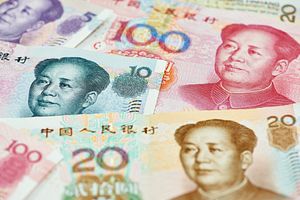It has been a confusing week for those observing China’s central bank, the People’s Bank of China (PBOC), trying to work out what the institution is thinking. During the last seven days, the main surprise was a dramatic slide in the renminbi (RMB) against the U.S. dollar, which created some heated debate about what was going on and why. Meanwhile, an apparent softening of central bank pressure on the money markets seemed to suggest a change from previous bouts of tightness squeezing.
Having appreciated fairly steadily for months, around February 18 the RMB began to creep downwards versus the dollar. Over seven days, the currency fell from what had become a fairly regular level of 6.06RMB to the dollar, down to a weaker 6.09RMB. This slide continued last week, and the currency closed the week out at 6.145RMB. The depreciation represents one of the fastest slides since the end of the full peg in 2005.
China’s financial system is becoming increasingly difficult to manage in a smooth and constant manner. The steady appreciation in the RMB over recent months (indeed years) has made any trade betting that benefits from the phenomenon a fairly “safe bet.” Market players across the globe have sought access to RMB assets or products benefiting from RMB appreciation as they cash in on the currency’s climb – which in turn puts further appreciation pressure on the latter.
Some of the investment products being used are complex and potentially volatile derivatives involving margin trading. Many will remember the huge currency hedging losses racked up by CITIC Pacific back in 2008 involving “targeted redemption forwards,” and it seems these have increasingly been used by Chinese firms to speculate on continued RMB appreciation.
A steadily increasing RMB also creates an opportunity for Chinese companies to borrow foreign currency (at low foreign interest rates), and then move the proceeds into RMB to take advantage of China’s higher interest rates. One of the methods to move such funds back into China is to “mis-invoice” exports, as was going on throughout late 2012 and early 2013. It seems this practice may be reviving. Borrowing this way creates a balance sheet currency mismatch that could be very destabilizing in the event of further RMB weakness – foreign currency loans (liabilities) become more and more expensive to service as the RMB falls (asset side).
So what is the PBOC up to? (and yes, this RMB fall was almost certainly the result of PBOC policy). There are several possible interpretations, which can be summarized thus: 1. This is a devaluation aimed at increasing export competitiveness in response to other emerging market currency weakness and China’s more shaky domestic economic performance; 2. The PBOC wants to rattle the cages of currency speculators by proving the RMB is not a “one way bet”; 3. The PBOC is preparing to either widen the daily trading band the RMB is allowed to move within, or instigate some other monetary policy change that is as yet unclear – but could include a major change to currency policy; 4. This is mostly about domestic liquidity and especially money market rates; the additional liquidity created by the currency’s weakening is not being fully sterilized, and is deliberately contributing to lower domestic rates.
It seems unlikely that this RMB weakness has been engineered to boost China’s export competitiveness (No. 1 above), which is now being hit harder by increasing input costs than currency strength. More probable is a combination of No. 2, No.4 and perhaps No.3. We will probably have to wait until after the upcoming parliament session in Beijing to get a better idea.
One thing remains certain though: China’s financial policymaking is becoming increasingly complex.

































